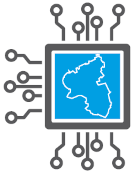ORALHYPE 2.0: Oral Health using Hyperspectral Imaging and Computer Vision
- Duration: 01.03.2023 - 28.02.2025
Funding Organization: DFG - Deutsche Forschungsgemeinschaft
Prof. Dr. Thomas Klauer
Mainz University of Applied SciencesSupported by DFG, this project strive to identify tumorous tissue from the human mouth and throat region automatically using hyperspectral imaging and AI-driven machine vision methods.
Motivation
Carcinoma is a malignancy. Carcinomas in humans are treated by surgical intervention in order to remove both, the altered tissue and conspicuous precursor lesions. Typically, the removal affects a large area for the sake of minimizing the risk of spread. Especially in the mouth and neck region, this therapy is disadvantageous for the patients aesthetics. For this reason, the project aims to identify tissue changes - particularly at the edges of the altered tissue - non-invasively and thus optimize the medical therapy standard expansively. To this end, the advantages of hyperspectral imaging and AI-based machine vision methods are going to be combined.
Activities
The project’s scope is to detect changes in the human mucosa automatically using machine lerning approaches. Therefore, creating high-quality and extensive training data is inevitable. This step represents the initial and one of the most integral milestone on the path to a successful project closure. Multiple ways of data analysis and appropriate model training will be connected to the data acquisition in favor of building a automated pipeline for real-time tissue change detection.
Results
The project kick-off in March 2023. Results are going to publish regularly in certain scientific publications.
Example of a hyperspectral scan of human mucosa Daniel Thiem, CC BY SA 4.0
Research-led process, starting from annotating hyperspectral data cubes to the development of an AI-guided training baseline aiming to collite both a training database and a model zoo.Bastian Plaß, CC BY SA 4.0
https://i3mainz.hs-mainz.de/en/projekte/oralhype2-0/
AI Focus Areas of the Research Project
Basic Research
- Machine Learning (ML): (Semi) Supervised Learning, Artificial Neural Network (ANN)
